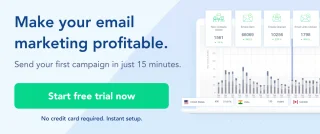Table of Contents
What is a Bulk Email List?
A bulk email list is a collection of email addresses of all the recipients in a company's database.
Bulk email lists will usually contain all subscribers you have from various channels, signup forms, and lead magnets. etc.
Bulk email lists are used to send a campaign or message that will be relevant to almost every subscriber in your mailing list. Some examples of these email messages, also known as mass email lists, are:
A weekly newsletter focused on delivering value to readers can be sent to everyone. The topic shouldn't be specific to a particular demographic or location only. It should cover broader themes that are common among your subscribers. E.g. a pet store might send a newsletter on the costs of owning a dog or any pet during colder weather conditions including information on expenses associated with checkups.
Product feature update: This is particularly useful if you are a SaaS or software business. Any new feature whether released for free trials or paid members will be relevant to your whole audience.
Store-wide discount campaign: If you are running a store-wide discount then that will be relevant to men, women, people who buy high ticket items or low ticket items, etc. Everyone can find something they like in the sale. So these can be sent to the bulk email list.
Types of Bulk Email Lists
There are broadly two types of bulk email lists: Regular and Targeted
Regular: This is the collection of all the emails of subscribers a company has.
This is great for sending messages that will be relevant to each and every subscriber. For example, a security update (if a company faced a security breach they need to inform all the stakeholders), a price increase (for example when Netflix increased prices worldwide, it was relevant to everyone).Targeted: This list is part of the larger list but subscribers here have some commonality. It's like segmenting the audience from the regular list. Even after segmenting, the number of subscribers on the list should be high. So segmentation here doesn't go many levels deep. For example, if there is a ride-hailing company and they are launching in a new city, they might send an email offering a discount to people of that city but within the subscribers' list, they will not segment further. Such a list would be called a targeted list.
The Myth & Truth about Bulk Email Lists
Myth: Emails sent to bulk email lists go to the spam folder.
Truth: Emails sent to the bulk list will go to the spam folder only if it is a bought or un-opted list or if you don't follow best practices.
Amateur marketers have this belief that if they send an email to a huge list (bulk list), their emails will go into the spam folder, their domain reputation will be impacted and basically, the campaign will be a fail.
But this happens if the bulk email list you have is bought from someone. If you are sending emails to people who have not opted in to receive your emails, they will mark your emails as spam. Multiple people marking your emails as spam will trigger the spam filters. This will lead to the rest of the emails being sent into the spam folder too.
This also happens when email best practices are not followed and the blame is put on the bulk email list. We have seen email lists with 100K-500K working fine even without any segmentation.
So let's look at some of the strategies you should follow.
Bulk Email List Strategies
1. Build your list organically
Building your list organically will give you a genuine audience who is interested in your content, services, and have high intent of buying from you. So instead of buying lists off the black market or scraping email IDs from social media websites, build a system to attract the right audience into your ecosystem.
Building a list organically is no small feat and it does take time, effort, and some creativity. But if you are thinking long term, it will be a good ROI for your business.
Some of the ideas to build a list organically:
Offer an incentive to people who visit your website to give their email address to you. It can be in the form of a free course, a downloadable guide, or just a newsletter that will help them.
Here is an example from emailmastery.org where they offer a free email course if you sign up.

At SendX we offer a 14-day trial to get people to subscribe to our list.

Run free webinars that train the audience on a particular skill.
Put the link to subscribe in your bio on social media platforms
Run a referral program incentivizing people to refer their friends in exchange for goodies, premium content, free subscriptions, etc.
You can visit this link where we have listed 25 ideas to build your list organically.
2. Email regularly but not too often
The frequency of your emails is important to nurture the subscribers already on your list. If you send emails too often, it will overwhelm people and they will either unsubscribe or stop reading your emails. If you send emails once in blue moon, people won't remember if they ever signed up and will unsubscribe.
So the key is to make a schedule, communicate in your initial communication with the list, and stick to it. You can decide how often you want to email - weekly, bi-weekly, or monthly. Anything more than monthly will be too little for communicating with your audience.
Once in a while, if there is an important announcement that can't wait for the schedule, that can go out but stick to a frequency as much as possible. This will also create a habit in people's minds to check your emails
3. Check email copy for spam triggers
The most common reason for emails landing into the spam folder is that they don't follow the best practices dictated by the inbox service providers who use spam filters to detect which emails might be spam or scams.
If your emails show the same behavior as someone who is trying to scam people then your emails will be blocked from going into the inbox. So here are a few dos and don'ts:
Don't attach any files to your emails. If you want to share anything, upload it to a hosting service and share the link in emails.
Proofread the email for proper grammar and spelling.
Don't shorten the link using any link shortening services. This shows that you are trying to hide the actual URL and makes it suspicious.
Maintain the text to image ratio. You can make it fully text-based but don't make it all one image. Image-only emails are usually blocked by spam filters.
If you want a detailed guide on how to avoid the spam folder, check this post on how to send bulk emails without spamming.
4. Observe data to keep track of list growth
The best part about using email marketing as a channel of growth for your business is that it can give you data-driven insights on how your audience is reacting to your offers, content, and messages.
In the case of sending emails to a bulk list, you should observe how your list is growing. This can be done by looking at subscribers you lose every time you send a bulk email. If you send a bulk email campaign to your whole list about a sale on just women's clothing, it's highly likely that the men in your list will unsubscribe, or vice-a-versa. So this should give you a hint that you should segment your list and not send it to the bulk list here.
A healthy list -growth will have more people subscribing to your content every week than the number of people unsubscribing. This data is fairly easy to get if you are using an email service provider (ESP).
5. Clean up your email list
A bulk email list with hundreds or thousands of subscribers will always have some email IDs that have either expired or are no longer in use. There will be subscribers who haven't opened your emails in 6 months or even a year. There is no point in keeping people on the list if they are not reading your emails.
Cleaning your email list will lower spam complaints, improve your open-rate and click-to-open rate, thus increasing your sender's reputation. This will help avoid your emails going to the spam folder in the long term. Using a bulk email verifier will help you remove invalid email addresses.
If you wish to know more about email list management and go deeper into the details of email list cleaning, check out this article on email list management here.
What's next?
Now that you know what a bulk email list is and how you can use the best practices to succeed in bulk email marketing, it's time to take your first step towards building a list. You should sign up for an ESP that will give you a signup form to collect emails, a system to manage the list, and tools to send emails while ensuring that they don't go into spam emails folder.
So I invite you to try out SendX which checks the boxes of what you need to have in an ESP to implement your bulk email list. You can sign up for the 14-day free trial and get access to all the features, tools, templates, customer service, etc. The best part is that it's a simple signup process of submitting your email address and no credit card is required. Click here to sign up for a 14-day free trial of SendX.
